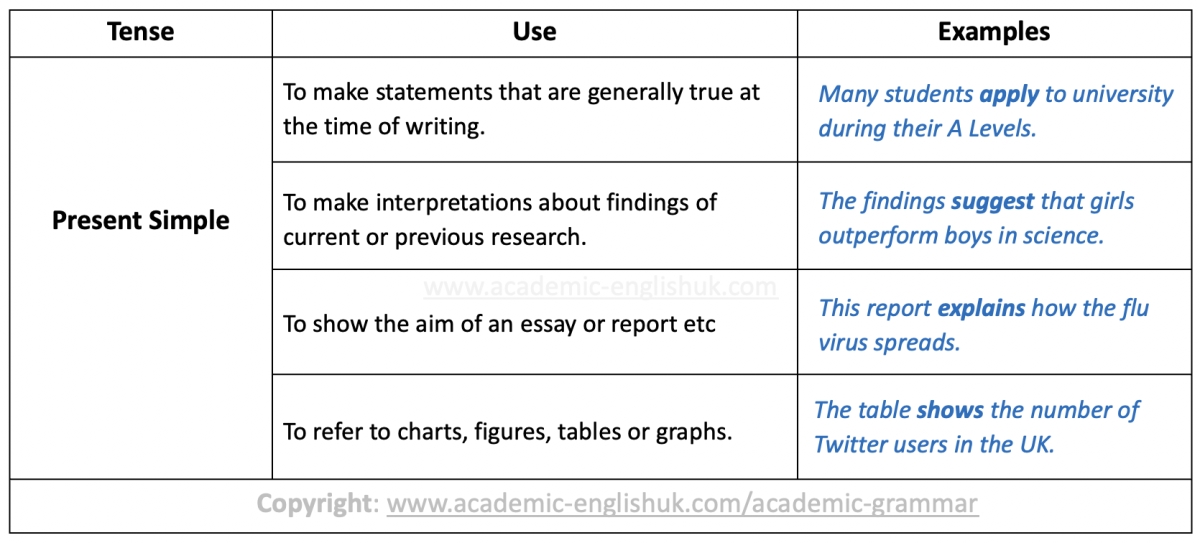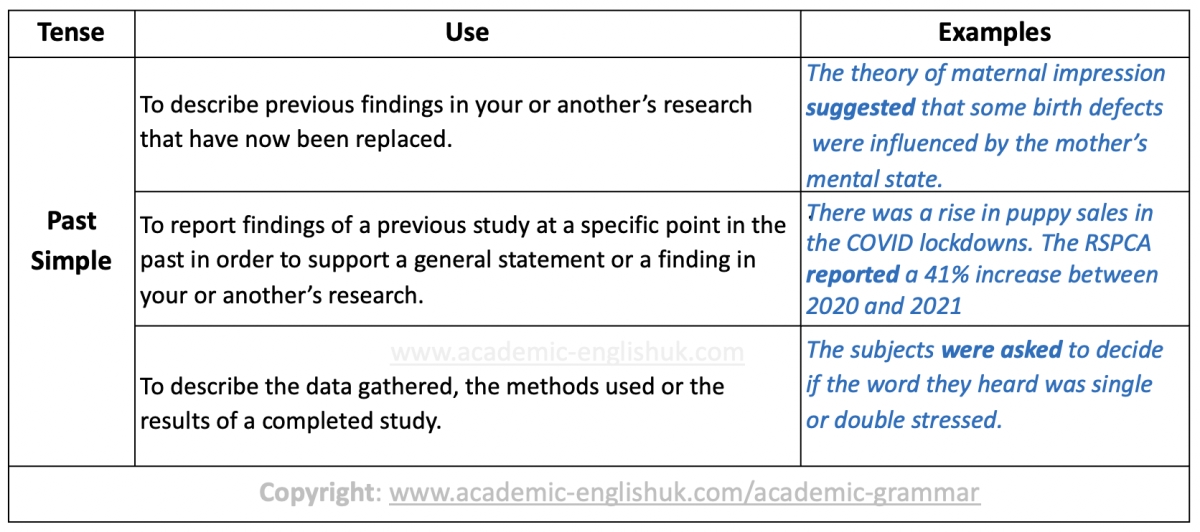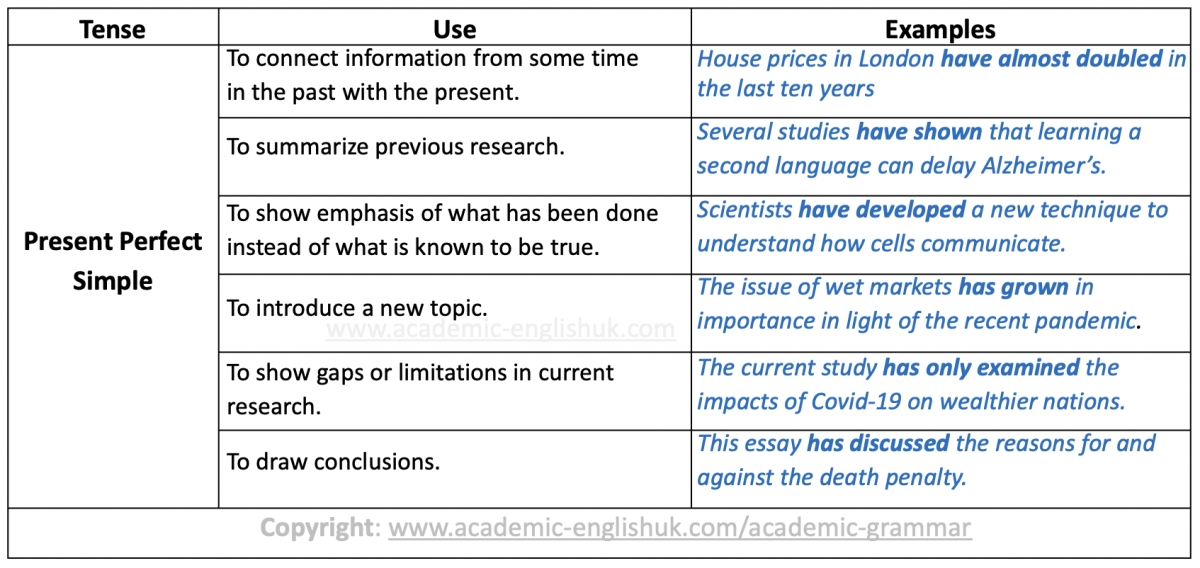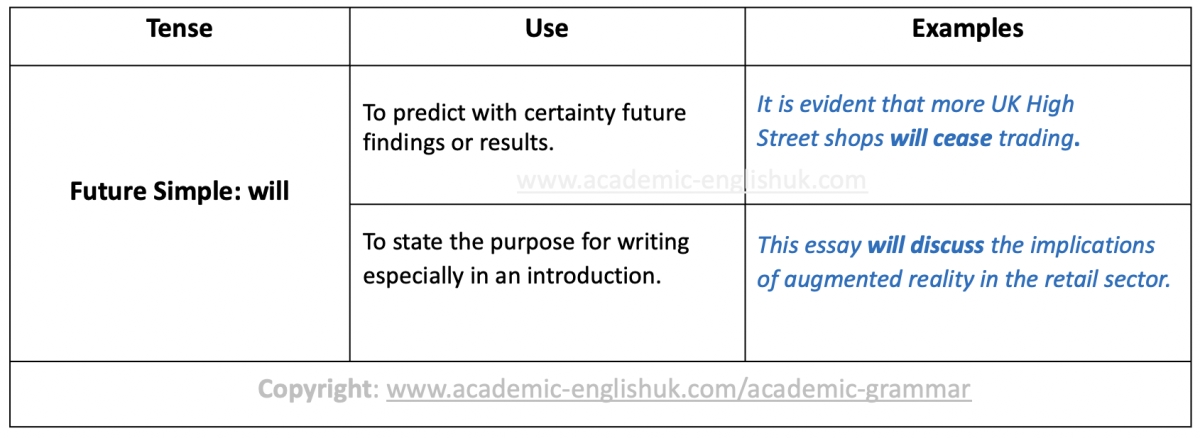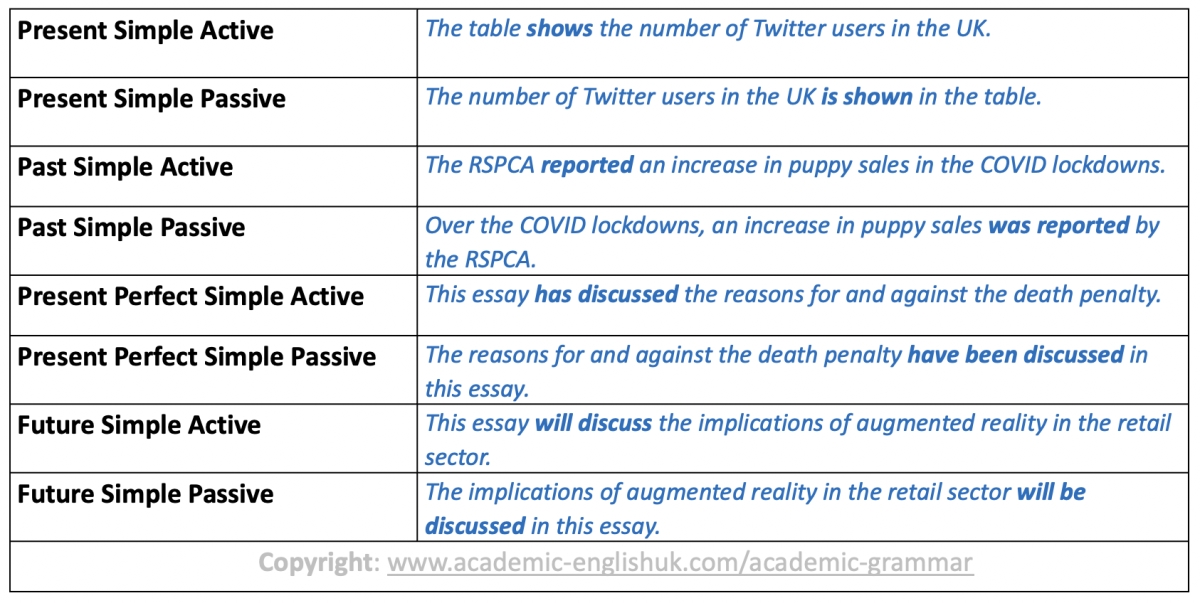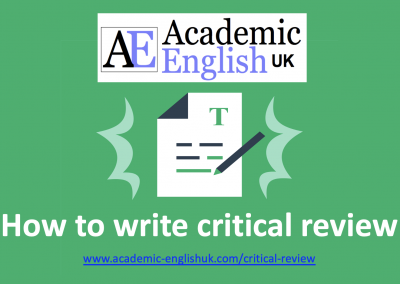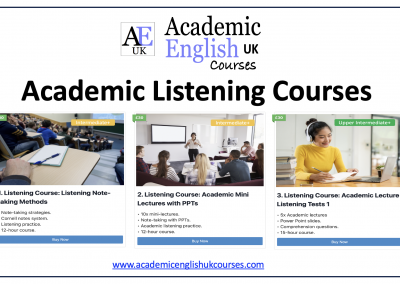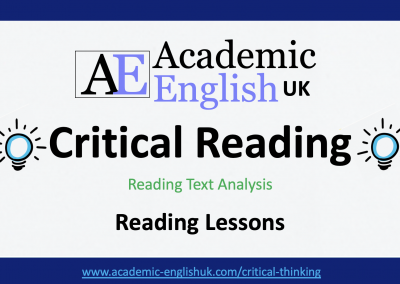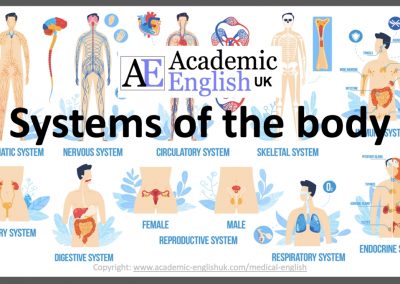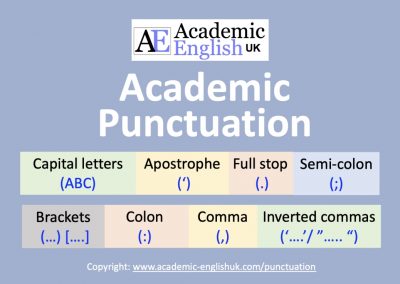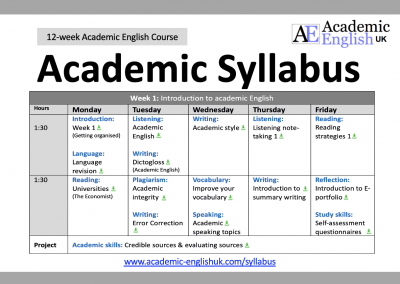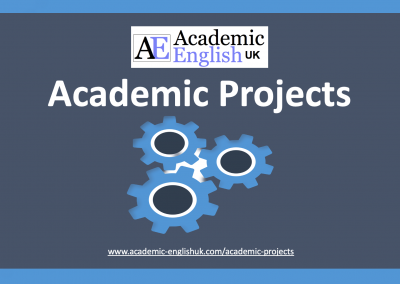Academic Grammar
What are the most common tenses in academic English?
- According to corpus research, in academic writing, the four tenses used the most often are present simple, past simple, present perfect simple and future simple (will) (Biber et al., 1999; Caplan, 2012).
- 80% – 85% of academic and technical English is in the present, including passives (Source: Longman Grammar of Written and Spoken English).
Academic Grammar Video
A short 7 minute video on the four most common tenses in academic English
Download worksheet for video: Word Doc
PDF Lesson Download
Academic Grammar 1: the four most common tenses in academic English [new 2021]
This lesson focuses on the four tenses: past simple, present simple, present perfect simple and future simple (will). It includes a language review of each tense, sentence level and paragraph level practice exercises. It also includes a freer writing practice at the end (with example paragraph). See worksheet example Time: 120mins. Level ***** [B1/B2/C1] TEACHER MEMBERSHIP / INSTITUTIONAL MEMBERSHIP
Exercise 1: Present simple vs past simple
Task: Identify the mistakes in the following sentences. Not all are incorrect.
For a detailed worksheet and more exercises – buy the download below.
Exercise 2: Present simple vs present perfect
For a detailed worksheet and more exercises – buy the download below.
Exercise 3: Past simple vs present perfect simple
For a detailed worksheet and more exercises – buy the download below.
Exercise 4: Present simple vs future simple (will)
For a detailed worksheet and more exercises – buy the download below.
Exercise 5: Tense Review
1. Government income _____________ from indirect taxation such as import duties. (derive)
2. Unemployment _____________ when economic growth outstrips productivity growth. (fall)
3. Over the last five years, major exporting countries _____________companies caught bribing foreign officials to win contracts. (prosecute)
4. Once the new resolution is approved, countries _____________to inspect any suspicious land, sea or air cargo, including luxury goods. (require)
5. The findings are based on responses from 500 business owners around the country who _____________ fewer than 100 employees. (have)
6. Every year, member states _____________ more available funding for agriculture subsidies. (demand)
For a detailed worksheet and more exercises – buy the download below.
Exercise 6: Paragraph gap fill
.
Exams versus coursework
The most effective way to assess students ______________ (long debate) in the field of education. Two of the most common methods are examinations and coursework. On the one hand, examinations ______________ (allow) teachers to assess several students at the same time on the same content. Exams are also seen by some as more flexible in relation to content, timing and question types. Indeed, a 2018 study led by Stanford University ______________ (show) that male students ____________ (achieve) higher scores with multiple-choice tasks whereas open-ended questions ________________ (enable) female students to perform better. On the other hand, …..
Exams versus coursework
The most effective way to assess students __has long been debated__ (long debate) in the field of education. Two of the most common methods are examinations and coursework. On the one hand, examinations ___allow___ (allow) teachers to assess several students at the same time on the same content. Exams are also seen by some as more flexible in relation to content, timing and question types. Indeed, a 2018 study led by Stanford University ____showed___(show) that male students ___achieve____(achieve) higher scores with multiple-choice tasks whereas open-ended questions ____enable___ (enable) female students to perform better. On the other hand, …..
For a detailed worksheet and more exercises – buy the download below.
Academic Grammar 1 Download
Academic Grammar 1: the four most common tenses in academic English [new 2021]
This lesson focuses on the four tenses: past simple, present simple, present perfect simple and future simple (will). It includes a language review of each tense, sentence level and paragraph level practice exercises. It also includes a freer writing practice at the end (with example paragraph). See worksheet example Time: 120mins. Level ***** [B1/B2/C1] TEACHER MEMBERSHIP / INSTITUTIONAL MEMBERSHIP
More grammar and vocabulary downloads...
Causes, Effects & Related Language
This lesson helps improve students' awareness of cause and effect language. It includes a language review section, lots of guided practice and freer paragraph writing practice (see worksheet example) Time: 60mins. Level ***** [B1/B2/C1] / Webpage link. / TEACHER MEMBERSHIP / INSTITUTIONAL MEMBERSHIP
Comparatives & Superlatives
This lesson helps improve students' awareness of compare and contrast language. It includes a language review section, lots of guided practice and freer paragraph writing practice (see worksheet example) Time: 60mins. Level ***** [B1/B2/C1] / Webpage link. / TEACHER MEMBERSHIP / INSTITUTIONAL MEMBERSHIP
Compare & contrast: comparatives and superlatives
This lesson helps improve students' awareness of compare and contrast language. It includes a language review section, lots of guided practice and freer paragraph writing practice (see worksheet example) Time: 60mins. Level ***** [B1/B2/C1]. / TEACHER MEMBERSHIP / INSTITUTIONAL MEMBERSHIP
Academic Conditionals
This lesson helps improve students' awareness of conditionals. It includes a language review section, lots of guided practice and freer paragraph writing practice (see worksheet example) Time: 60mins. Level ***** [B1/B2/C1] TEACHER MEMBERSHIP / INSTITUTIONAL MEMBERSHIP
Countable and uncountable nouns
This lesson helps improve students' awareness of countable & uncountable nouns. It includes a language review section, lots of guided practice and freer paragraph writing practice (see worksheet example) Time: 60mins. Level ***** [B1/B2/C1] TEACHER MEMBERSHIP / INSTITUTIONAL MEMBERSHIP
Modal Auxiliary Verbs
This lesson helps improve students' awareness of modal verbs. It includes a language review section, lots of guided practice and freer paragraph writing practice (see worksheet example) Time: 60mins. Level ***** [B1/B2/C1] TEACHER MEMBERSHIP / INSTITUTIONAL MEMBERSHIP
 Nominalisation (verbs / adjectives to nouns)
Nominalisation (verbs / adjectives to nouns)
An introduction to nominalisation. This worksheet shows the basics of nominalising, practises changing verbs and adjectives to nouns, and includes four exercises from guided practice through to freer practice. Very good writing practice activity with a fair amount of challenge for all levels. Level ***** [B1/B2/C1] (see example sheet) TEACHER MEMBERSHIP / INSTITUTIONAL MEMBERSHIP
*
 Noun Phrases Worksheet 1
Noun Phrases Worksheet 1
This lesson highlights what noun phrases are and provides valuable practice. It focuses on the key concepts of quantifiers, adjectives and nouns, noun + noun, noun + preposition and noun phrase combinations (example). Level ***** [B2/C1] / TEACHER MEMBERSHIP / INSTITUTIONAL MEMBERSHIP
*
 Noun Phrases Worksheet 2
Noun Phrases Worksheet 2
This lesson is designed to help students write more concisely by using noun phrases. It takes students through a whole range of tasks including noticing the language in context, eight guided practice tasks and five freer practice activities. There's a language review sheet included too (see example). Level ***** [B2/C1] TEACHER MEMBERSHIP / INSTITUTIONAL MEMBERSHIP
*
Academic Passive Structures & Nominalisation
An introduction to the impersonal passive structure 'it is said that...' , to infinitive passive form ' it is claimed to be...'. and how to nominalise verbs to nouns to show formality in writing. This worksheet provides key information and 10 writing questions (example). Level ***** [B1/B2/C1] TEACHER MEMBERSHIP / INSTITUTIONAL MEMBERSHIP
*
Relative clauses: defining & non-defining clauses
This lesson is to support students in their understanding and use of defining & non-defining relative clauses.The lesson includes four tasks of guided practice and two tasks of freer practice (see worksheet example) Time: 60mins. Level ***** [B1/B2/C1]. / TEACHER MEMBERSHIP / INSTITUTIONAL MEMBERSHIP
Sentence Structure 1: Simple, compound, complex & complex compound
This lesson is to support students in their understanding and practice of the four types of sentence structures: simple, compound, complex and complex-compound. It includes noticing, guided and freer practice (see worksheet example) Time: 60mins. Level ***** [B1/B2/C1] / TEACHER MEMBERSHIP / INSTITUTIONAL MEMBERSHIP
Sentence Structure 2: Fragment, run-on & comma splice sentences
This lesson helps improve students' sentence structure through identifying and practising fragments, run-ons and comma splice sentences. It includes noticing, guided and freer practice (see worksheet example) Time: 60mins. Level ***** [B1/B2/C1]/ TEACHER MEMBERSHIP / INSTITUTIONAL MEMBERSHIP
Sentence Structure 3: Complex sentence structure (STEM)
This lesson is to support students in their understanding and practice of complex sentence structure. The worksheets focus on three structures: adverbial, adjective and noun clauses and contain key explanations and sentence and paragraph-level practice within a STEM context (see worksheet example) Time: 90mins. Level ***** [B1/B2/C1] TEACHER MEMBERSHIP / INSTITUTIONAL MEMBERSHIP
X
Tense Review (3 lessons: analysis, gap fill, speaking)
This is a great lesson to introduce / revise English Tenses. Lesson 1: students discuss a number of sentences & identify the tense & reason for use. Give out Tense handout (here) to consolidate. Lesson 2: tense review gap fill. Lesson 3: speaking exercise with lots of questions using the tenses. Example Level ***** [B1/B2/C1] TEACHER MEMBERSHIP / INSTITUTIONAL MEMBERSHIP
Verb Patterns
This lesson helps improve students' awareness of verb patterns (verb + infinitive, verb + to infinitive, verb + gerund, verb + that clause, verb + wh-clause) . It includes a language review section, lots of guided practice and freer paragraph writing practice (see worksheet example) Time: 60mins. Level ***** [B1/B2/C1] TEACHER MEMBERSHIP / INSTITUTIONAL MEMBERSHIP


